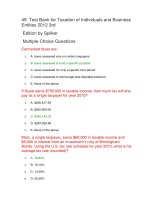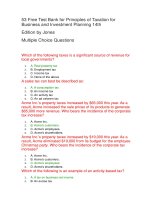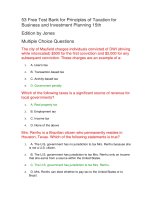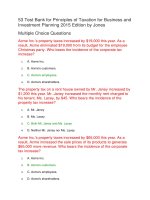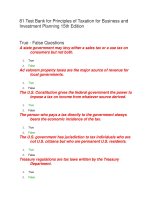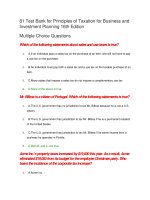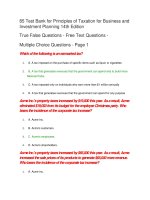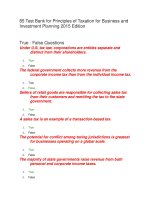Test bank for principles of auditing and other assurance services 18th
Bạn đang xem bản rút gọn của tài liệu. Xem và tải ngay bản đầy đủ của tài liệu tại đây (34 KB, 9 trang )
Test Bank for Principles of Auditing and Other
Assurance Services 18th
Edition by Whittington
Multiple Choice Questions
An operational audit differs in many ways from an audit of
financial statements. Which of the following is the best example of
one of these differences?
1.
A. The usual audit of financial statements covers the four basic statements,
whereas the operational audit is usually limited to either the balance sheet or
the income statement.
2. B. The boundaries of an operational audit are often drawn from an
organization chart and are not limited to a single accounting period.
3. C. Operational audits do not ordinarily result in the preparation of a report.
4. D. The operational audit deals with pre-tax income.
The Statements on Auditing Standards have been issued by the:
1.
2.
3.
4.
A. Auditing Standards Board.
B. Financial Accounting Standards Board.
C. Securities and Exchange Commission.
D. Federal Bureau of Investigation.
Which of the following are issued by the Securities and Exchange
Commission?
1.
2.
3.
4.
A. Accounting Research Studies.
B. Accounting Trends and Techniques.
C. Industry Audit Guides.
D. Financial Reporting Releases.
The review of a company's financial statements by a CPA firm:
1.
2.
3.
A. Is substantially less in scope of procedures than an audit.
B. Requires detailed analysis of the major accounts.
C. Is of similar scope as an audit and adds similar credibility to the
statements.
4. D. Culminates in issuance of a report expressing the CPA's opinion as to
the fairness of the statements.
Which of the following types of services is generally provided only
by CPA firms?
1.
2.
A. Tax audits.
B. Financial statement audits.
3.
4.
C. Compliance audits.
D. Operational audits.
Which of the following attributes most clearly differentiates a CPA
who audits management's financial statements as contrasted to
management?
1.
2.
3.
4.
A. Integrity.
B. Competence.
C. Independence.
D. Keeping informed on current professional developments.
The FDIC Improvement Act requires that management of large
financial institutions engage auditors to attest to assertions by
management about the effectiveness of the institution's internal
controls over:
1.
2.
3.
4.
A. Compliance with laws and regulations.
B. Financial reporting.
C. Effectiveness of operations.
D. Efficiency of operations.
Passage of the Sarbanes-Oxley Act led to the establishment of
the:
1.
2.
3.
4.
A. Auditing Standards Board.
B. Accounting Enforcement Releases Board.
C. Public Company Accounting Oversight Board.
D. Securities and Exchange Commission.
The organization charged with protecting investors and the public
by requiring full disclosure of financial information by companies
offering securities to the public is the:
1.
2.
3.
4.
A. Auditing Standards Board.
B. Financial Accounting Standards Board.
C. Government Accounting Standards Boards.
D. Securities and Exchange Commission.
The serially-numbered pronouncements issued by the Auditing
Standards Board over a period of years are known as:
1.
2.
3.
4.
A. Auditing Statements of Position (ASPs).
B. Accounting Series Releases (ASRs).
C. Statements on Auditing Standards (SASs).
D. Statements on Auditing Principles (SAPs).
Inquiries and analytical procedures ordinarily form the basis for
which type of engagement?
1.
2.
3.
4.
A. Agreed-upon procedures.
B. Audit.
C. Examination.
D. Review.
Which of the following best describes the reason why
independent auditors report on financial statements?
1.
A. A management fraud may exist and it is more likely to be detected by
independent auditors.
2. B. Different interests may exist between the company preparing the
statements and the persons using the statements.
3. C. A misstatement of account balances may exist and is generally corrected
as the result of the independent auditors' work.
4. D. Poorly designed internal control may be in existence.
Which of the following terms best describes the audit of a
taxpayer's tax return by an IRS auditor?
1.
2.
3.
4.
A. Operational audit.
B. Internal audit.
C. Compliance audit.
D. Government audit.
A summary of findings rather than assurance is most likely to be
included in a(n):
1.
2.
3.
4.
A. Agreed-upon procedures report.
B. Compilation report.
C. Examination report.
D. Review report.
Which statement is correct with respect to continuing professional
education (CPE) requirements of members of the AICPA?
1.
A. Only members employed by the AICPA are required to take such
courses.
2. B. Only members in public practice are required to take such courses.
3. C. Members, regardless of whether they are in public practice, are required
to meet such requirements.
4. D. There is no requirement for members to participate in CPE.
Which of the following professionals has primary responsibility for
the performance of an audit?
1.
2.
3.
4.
A. The managing partner of the firm.
B. The senior assigned to the engagement.
C. The manager assigned to the engagement.
D. The partner in charge of the engagement.
When compared to an audit performed prior to 1900, an audit
today:
1.
2.
A. Is more likely to include tests of compliance with laws and regulations.
B. Is less likely to include consideration of the effectiveness of internal
control.
3. C. Has bank loan officers as the primary financial statement user group.
4. D. Includes a more detailed examination of all individual transactions.
The Government Accountability Office (GAO):
1.
A. Is primarily concerned with rapid processing of all accounts payable
incurred by the federal government.
2. B. Conducts operational audits and reports the results to Congress.
3. C. Is a multinational organization of professional accountants.
4. D. Is primarily concerned with budgets and forecasts approved by the SEC.
Operational auditing is primarily oriented toward:
1.
2.
3.
A. Future improvements to accomplish the goals of management.
B. The accuracy of data reflected in management's financial records.
C. The verification that a company's financial statements are fairly
presented.
4. D. Past protection provided by existing internal control.
Which of the following is not correct relating to the SarbanesOxley Act?
1.
2.
3.
A. It toughens penalties for corporate fraud.
B. It restricts the types of consulting CPAs may perform for audit clients.
C. It created the Public Company Accounting Oversight Board (PCAOB) as
a replacement for the Financial Accounting Standards Board.
4. D. It eliminates a significant portion of the accounting profession's system
of self-regulation.
The attest function:
1.
A. Is an essential part of every engagement by the CPA, whether
performing auditing, tax work, or other services.
2. B. Includes the preparation of a report of the CPA's findings.
3. C. Requires a consideration of internal control.
4. D. Requires a complete review of all transactions during the period under
examination.
Historically, which of the following has the AICPA been most
concerned with providing?
1.
2.
3.
4.
A. Professional standards for CPAs.
B. Professional guidance for regulating financial markets.
C. Standards guiding the conduct of internal auditors.
D. Staff support to Congress.
Governmental auditing often extends beyond examinations
leading to the expression of opinion on the fairness of financial
presentation and includes audits of efficiency, economy,
effectiveness, and also:
1.
2.
3.
4.
A. Accuracy.
B. Evaluation.
C. Compliance.
D. Internal control.
A typical objective of an operational audit is for the auditor to:
1.
A. Determine whether the financial statements fairly present the entity's
operations.
2. B. Evaluate the feasibility of attaining the entity's operational objectives.
3. C. Make recommendations for improving performance.
4. D. Report on the entity's relative success in attaining profit maximization.
The risk associated with a company's survival and profitability is
referred to as:
1.
2.
3.
4.
A. Business Risk.
B. Information Risk.
C. Detection Risk.
D. Control Risk.
Attestation risk is limited to a low level in which of the following
engagement(s)?
1.
2.
3.
4.
A. Both examinations and reviews.
B. Examinations, but not reviews.
C. Reviews, but not examinations.
D. Neither examinations nor reviews.
The risk that information is misstated is referred to as:
1.
2.
3.
4.
A. Information risk.
B. Inherent risk.
C. Relative risk.
D. Business risk.
The right to practice as a CPA is given by which of the following
organizations?
1.
2.
3.
4.
A. State Boards of Accountancy.
B. The AICPA.
C. The SEC.
D. The General Accounting Office.
An integrated audit performed under the Sarbanes-Oxley Act
requires that auditors report on: financial statement: A)yes, B)yes;
C)no; D)No. Internal Control: A)yes, B)no; C)yes; D)No.
1.
2.
3.
4.
A. Option A
B. Option B
C. Option C
D. Option D
An engagement in which a CPA firm arranges for a critical review
of its practices by another CPA firm is referred to as a(n):
1.
2.
3.
4.
A. Peer Review Engagement.
B. Quality Control Engagement.
C. Quality Assurance Engagement.
D. Attestation Engagement.
The risk that a company will not be able to meet its obligations
when they become due is an aspect of:
1.
2.
3.
4.
A. Information risk.
B. Inherent risk.
C. Relative risk.
D. Business risk.
20 Free Test Bank for Cornerstones of Managerial
Accounting 4th Edition by Mowen Multiple Choice
Questions
Which of the following is an example of the management activity
referred to as planning?
1.
2.
3.
4.
Developing a strategy for disposing of hazardous waste.
The decision to eliminate an unprofitable segment of an organization.
The decision to outsource an organization's payroll processing.
All of these are correct
Developing a company strategy for responding to anticipated new
markets is an example of
1.
2.
3.
4.
planning.
controlling.
decision making.
all of these are correct.
Accountants that have a Certificate in Public Accounting (CPA):
1.
are the only accountants permitted to serve as external auditors.
2.
must pass a national examination and be licensed by the state in which
they practice.
3. may be held responsible to provide assurance concerning the reliability of a
firm's financial statements.
4. all of these statements are true.
Investigating production variances and adjusting the production
process is an example of
1.
2.
3.
4.
planning.
controlling.
decision making.
all of these.
Financial accounting
1.
2.
3.
4.
is concerned with the information about the firm as a whole.
has to adhere to GAAP policies.
focuses on external users.
all of these are correct
Which of the following would occupy a line position in a hospital?
1.
2.
3.
4.
manager of the cafeteria
hospital administrator
chief of surgery
none of these
Managerial accounting
1.
2.
3.
4.
is primarily for external users.
has no mandatory rules.
provides information based on historical information.
must adhere to GAAP.
The primary objective of managerial accounting is
1.
to provide stockholders and potential investors with useful information for
decision making.
2. to provide banks and other creditors with information useful in making credit
decisions.
3. to provide management with information useful for planning and control of
operations.
4. to provide the Internal Revenue Service with information about taxable
income.
Which of the following is not an objective of managerial
accounting?
1.
To prepare external reports for investors, creditors, government agencies,
and other outside users.
2.
To provide information for costing of services, products, and other objects of
interest to management.
3. To provide information for planning, controlling, evaluating and continuous
improvement.
4. To provide information for decision making.
Which of the following would normally occupy a line position?
1.
2.
3.
4.
staff accountant
accounting manager
vice-president of marketing
treasurer
Which of the following would normally occupy a staff position?
1.
2.
3.
4.
assembly worker
cost accounting manager
factory manager
all of these
Which of the following areas is not emphasized on the CMA
examination?
1.
2.
3.
4.
external auditing and business law
economics, finance, and management
decision analysis and information systems
financial accounting and reporting
The objective of profit maximization
1.
2.
3.
4.
should be the only goal of an organization.
is an objective of financial accounting but not managerial accounting.
should be achieved through legal and ethical means.
should outweigh the goal of product quality.
Managerial accounting reports are prepared
1.
2.
3.
4.
according to GAAP guidelines.
to meet the needs of decision makers within the firm.
for external users.
all of these are correct
The controller of an organization participates in
1.
2.
3.
4.
planning.
controlling.
decision making.
all of these are correct
Total quality management emphasizes
1.
zero defects.
2.
3.
4.
continuous improvement.
elimination of waste.
all of these are correct.
Persons in the United States who provide assurance service are
designated as
1.
2.
3.
4.
Certified Public Accountants.
Certified Financial Accountants.
Chartered Accountants.
Certified Management Accountants.
Which of the following would not be an example of a value-added
activity?
1.
2.
3.
4.
timely delivery of products
offering the customer a variety of products
storage of finished products
excellent customer service
The standards of ethical conduct for managerial accountants
include
1.
2.
3.
4.
competence and performance.
integrity and respect for others.
confidentiality, confidence, integrity, and observance.
competence, confidentiality, integrity, and credibility.
Activity-based costing
1.
strives to create an environment that will enable works to manufacture zerodefect products.
2. is the process of choosing among competing alternatives.
3. was established in response to financial scandals.
4. encourages process-value analysis.
